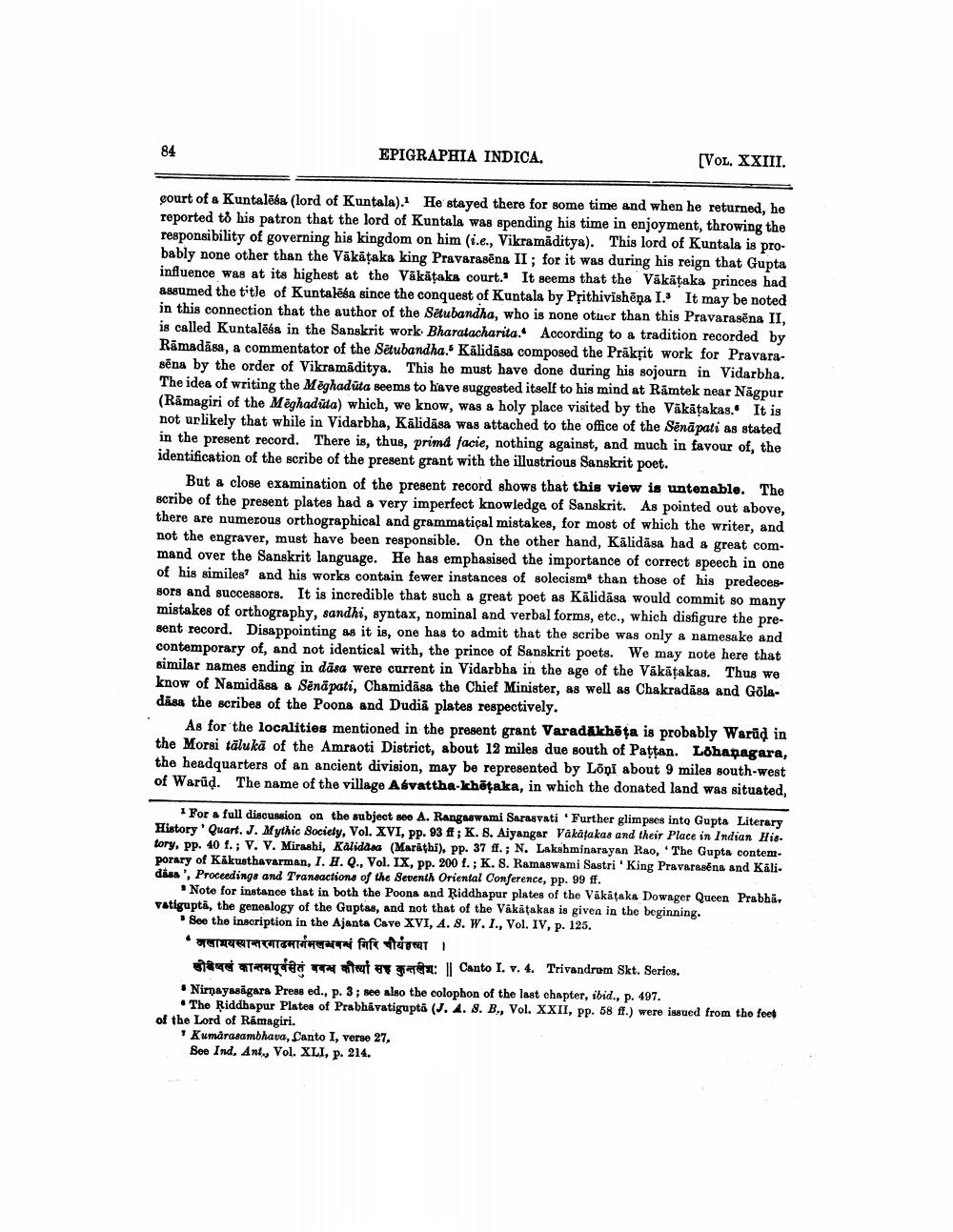________________
EPIGRAPHIA INDICA.
[VOL. XXIII.
court of a Kuntalēša (lord of Kuntala). He stayed there for some time and when he returned, he reported to his patron that the lord of Kuntala was spending his time in enjoyment, throwing the responsibility of governing his kingdom on him (i.e., Vikramaditya). This lord of Kuntala is probably none other than the Vākāțaka king Pravarasēna II; for it was during his reign that Gupta influence was at its highest at the Vākāțaka court. It seems that the Vākāțaka princes had assumed the title of Kuntalēša since the conquest of Kuntala by Prithivishēņa I. It may be noted in this connection that the author of the Satubandha, who is none otuor than this Pravarasēna II, is called Kuntalēša in the Sanskrit work Bharatacharita. According to a tradition recorded by Rāmadāsa, & commentator of the Setubandha. Kālidāsa composed the Präkțit work for Pravarasēna by the order of Vikramāditya. This he must have done during his sojourn in Vidarbha. The idea of writing the Meghaduta seems to have suggested itself to his mind at Ramtek near Nagpur (Rāmagiri of the Mėghadüta) which, we know, was a holy place visited by the Vākāțakas. It is not urlikely that while in Vidarbha, Kālidāsa was attached to the office of the Sēnāpati as stated in the present record. There is, thus, primd facie, nothing against, and much in favour of, the identification of the scribe of the present grant with the illustrious Sanskrit poet.
But a close examination of the present record shows that this view is untenable. The scribe of the present plates had a very imperfect knowledge of Sanskrit. As pointed out above, there are numerous orthographical and grammatical mistakes, for most of which the writer, and not the engraver, must have been responsible. On the other hand, Kālidasa had a great command over the Sanskrit language. He has emphasised the importance of correct speech in one of his similes and his works contain fewer instances of solecism than those of his predecessors and successors. It is incredible that such a great poet as Kālidāsa would commit so many mistakes of orthography, sandhi, syntax, nominal and verbal forms, etc., which disfigure the present record. Disappointing as it is, one has to admit that the scribe was only a namesake and contemporary of, and not identical with, the prince of Sanskrit poets. We may note here that similar names ending in dasa were current in Vidarbha in the age of the Väkātakas. Thus we know of Namidāsa & Senapati, Chamidāsa the Chief Minister, as well as Chakradāsa and Gõladäss the scribes of the Poons and Dudia plates respectively.
As for the localities mentioned in the present grant VaradAlchēta is probably Warūd in the Morsi tālukā of the Amraoti District, about 12 miles due south of Pattan. Lühapagara, the headquarters of an ancient division, may be represented by Lõni about 9 miles south-west of Warūd. The name of the village Asvattha-Ihotaka, in which the donated land was situated,
1 For a full discussion on the subject see A. Rangaswami Sarasvati 'Further glimpses into Gupta Literary History ' Quart. J. Mythic Society, Vol. XVI, pp. 93 ff; K. 8. Aiyangar Vakatakas and their place in Indian His. tory, pp. 40 f.; V. V. Mirashi, Kalidasa (Marathi), PP. 37 ff.; N. Lakshminarayan Rao, 'The Gupta contem. porary of Kakusthavarman, I. H. Q., Vol. IX, pp. 200 f.; K. S. Ramaswami Sastri 'King Pravaraséna and Kali. dass , Proceedings and Transactions of the Seventh Oriental Conference, pp. 99 ff.
• Note for instance that in both the Poona and Riddhapur plates of the Vakataka Dowager Queen Prabha. vatiguptă, the genealogy of the Guptas, and not that of the Vakatakas is given in the beginning.
See the inscription in the Ajanta Cave XVI, 4. 8. W. I., Vol. IV, p. 125. 'मलामयस्थान्तरगाढमार्गमलबबन्ध गिरि चौर्यहत्या ।
4 radex et garen || Canto I. v. 4. Trivandrum Skt. Serios. Nimayasigara Press ed., p. 3 ; see also the colophon of the last chapter, ibid., p. 497.
• The Riddhapur Plates of Prabhavatigupta (J. A. 8. B., Vol. XXII, pp. 58 ff.) were issued from the feet of the Lord of Råmagiri.
Kumarasambhava, Santo I, verse 27, See Ind. Ani., Vol. XLI, p. 214.




